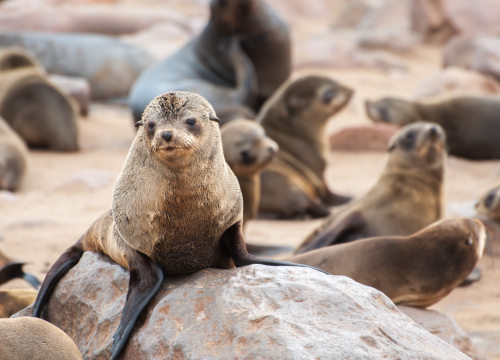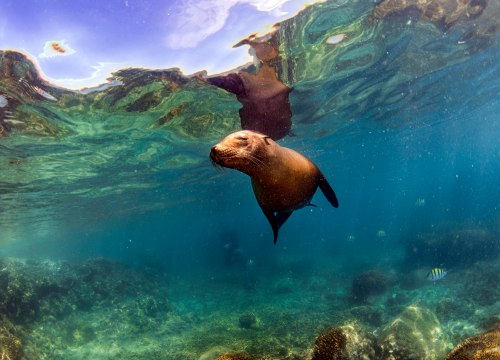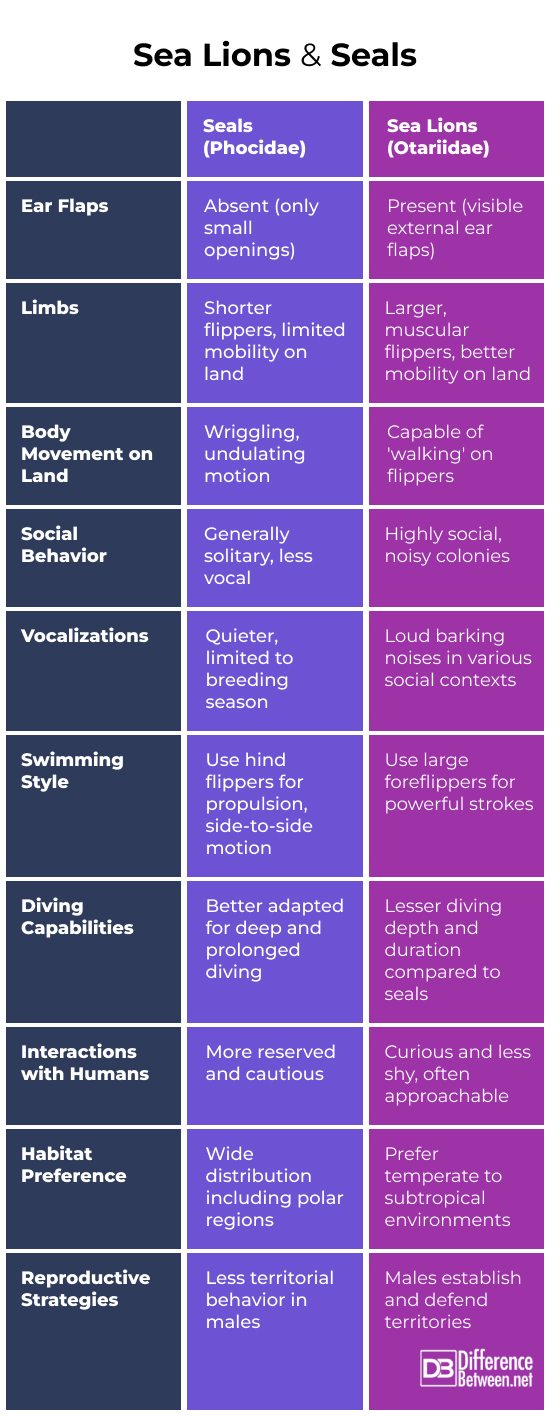Difference Between Seals and Sea Lions
Introduction
When we gaze out at the vast ocean, the playful antics of marine mammals like seals and sea lions often captivate us. We’ll look at these two distinct yet sometimes confused marine animals. The Phocidae family of seals is characterized by its sleek body, small flippers, and ear holes. Seas in the Arctic and Antarctic are more appealing to them. Conversely, they may also hunt in communities or groups. The family Otariidae includes sea lions. To aid with terrestrial navigation, they have enlarged front flippers and external ear flaps. On beaches, they engage in a great deal of social activity.
Differentiating these two marine animals is made easier by their diverse ear structures, flippers, vocalization, and social activities, even though they both inhabit similar environments and consume similar foods.

Seals
Defining Seals: Phocidae Family Characteristics
The Phocidae family encompasses a diverse range of marine mammals commonly referred to as seals. These creatures are characterized by their fusiform, hydrodynamic bodies, a design quintessential for adept aquatic maneuverability. A notable absence of external ear flaps and the presence of compact forelimbs, evolved into functional flippers, typify their morphology. This streamlined anatomy, while facilitating proficient aquatic locomotion, results in a conspicuously laborious and undulating movement on terrestrial surfaces.
Habitats and Behavioral Patterns
Seals exhibit a remarkable ecological versatility, inhabiting a spectrum of marine environments from the polar ice sheets to temperate and tropical waters. Their behavioral ecology is intriguingly varied; while generally solitary, seals engage in transient social aggregations, primarily during the breeding season. These aggregations, or rookeries, are temporary and typically lack the intricate social dynamics seen in more gregarious marine mammals.
Dietary Preferences and Social Dynamics
Predominantly piscivorous, seals’ diets are primarily composed of fish, though many species exhibit a dietary flexibility that includes cephalopods such as squids. The foraging behaviors and prey specificity can differ markedly among species, influenced by ecological variables and availability of prey. Social interactions outside of breeding seasons are minimal, with no pronounced evidence of enduring social bonds or complex hierarchical structures.

Sea Lions
Defining sea lions: Characteristics of Otariidae Family Members
Distinct from their Phocidae counterparts, sea lions (family Otariidae) are identifiable by their distinctive external ear flaps and robust forelimbs. These limbs are not only instrumental in terrestrial mobility, allowing a more upright and agile locomotion, but also play a crucial role in their swimming technique, characterized by powerful strokes of their fore-flippers.
Habitats and Behavioral Patterns
Sea lions are predominantly coastal dwellers, frequenting the shores and off-shore areas of the Pacific and Southern Hemispheres. Their social proclivities are markedly more pronounced than seals, with sea lions forming large, vocal, and interactive colonies. These groupings exhibit a range of complex social behaviors, from hierarchical territorialism to intricate communicative interactions.
Dietary Preferences and Social Dynamics
While their dietary habits largely mirror those of seals, focusing on fish and cephalopods, sea lions occasionally demonstrate a more opportunistic approach to feeding, including a wider range of marine organisms in their diet. The social structure within sea lion colonies is characterized by more complex and enduring social relationships, with dominant individuals often asserting hierarchical positions within these communities.
Sea Lions and Seals May Be Similar
Seals and sea lions have various traits that demonstrate their pinnipedal evolution.
Aquatic Lifestyle: Marine Masters
Aquatic seals and sea lions are uniquely adapted. Their flippers, streamlined bodies, and other adaptations indicate an oceanic lifestyle. They can hunt, navigate, and deep dive underwater thanks to their modifications. Aquatic inclination is a key ecological similarity between the taxa.
Dietary Similarities: Deep Predators
Seal and sea lion diets are similar in that they like marine foods. They eat mostly fish and cephalopods, representing a predatory specialization in maritime habitats. This nutritional overlap shows their similar ecological roles as marine predators.
Grouping: Pinniped Connection
Seals and sea lions are pinnipeds, a varied group of semi-aquatic marine mammals. This classification suggests a single evolutionary lineage, as both groups have adaptations for life at the land-sea interface.
Breeding Habits: Alone to Social
Despite their different social systems, seals and sea lions behave similarly during breeding season. During this time, rookeries or breeding colonies form for mating and raising young. Seasonal aggregations show a shared reproductive strategy in the pinniped order, contrasting their otherwise diverse social characteristics.
What distinguishes seals from sea lions? Key Differences Comparison
Although modest, seal and sea lion differences affect their ecological niches, behaviors, and environmental interactions.
Physical Differences
- Outer ear flaps distinguish sea lions from seals. Small apertures near seals’ heads allow hearing.
- These creatures have unusual hindlimbs and forelimbs. Sea lions can run rapidly on land due to their powerful forelimbs. Smaller, less efficient land limbs cause seals’ undulation.
- Different limb structures demand different land movement techniques. Sea lions can ‘walk’ on land with their stronger, more flexible flippers. Seals wriggle.
Social and vocal behavior
- Seals reproduce and live alone. Sea lions live in big groups.
- These species’ vocal repertoires vary. Only during breeding do seals shout. Sea lion colonies socialize by barking loudly.
Dive and swim adaptations
- Sea lions propel themselves using their larger foreflippers, while seals swim sideways.
- Seals can dive deeper and submerge longer than sea lions. Their reduced size and oxygen-saving adaptations allow this.
People-related interactions
- Seals fear humans and shun touch. The timidity decreases their visibility in human-occupied environments.
- Sea Lions: Sea lions are curious and brave around humans. They are more friendly and active nearshore, so they know each other.

Summary
Seals and sea lions vary, which helps explain their role in marine ecosystems. Their behavior, appearance, and relationships with humans and nature identify them.
Seals’ absence of external ear flaps and shorter flippers make them superior at deep and prolonged dives but less nimble on land. They are solitary and quieter than sociable, louder sea lions with prominent ear flaps and bigger, more muscular flippers for terrestrial mobility. Sea lions are cheerful and interested with humans, whereas seals are shy.
These distinctions reflect unique marine niche adaptations beyond physical and behavioral features. Marine creatures like sea lions and seals may survive mild and colder climes.
FAQs
Which is more aggressive seal or sea lion?
Seals are less aggressive than sea lions. Their sociality, territorial male behavior, and confidence around humans and other animals support this. Seals and sea lions, like any animal, can attack if threatened or protecting their young.
Are seals and sea lions closely related?
Sea lions resemble seals. Both are walrus-like pinnipeds. Seals are Phocidae, sea lions Otariidae. Their shared aquatic behaviors and meals illustrate their deep bond despite their morphological and behavioral differences.
Do sea lions and seals get along?
Wild seals and sea lions rarely encounter due to their different social structures and habits. Despite sharing habitats and living peacefully, they rarely interact.
Do seals and sea lions both bark?
Usually only sea lions bark. Seals communicate differently and bark less. Sea lions bark to socialize.
What are the 4 main differences between seals and sea lions?
- Seals lack ear flaps, unlike sea lions.
- Sea lions can ‘walk’ with their larger flippers, while seals squirm on land.
- Seals live alone, but sea lions form large colonies.
- Seals are quieter than barking sea lions.
Can a seal and sea lion mate?
Seals and sea lions cannot mate. Genetically distinct species exclude interbreeding.
Are seals friendly to humans?
Seals rarely confront humans. Wild animals avoid humans. Respectfully separate yourself to avoid stress and harm.
Can sea lions be friendly?
Sea lions are friendly, therefore many appear so curious and less shy than seals around humans. Players can play in human-occupied areas. Respect their space—they’re wild animals.
Can you pet a sea lion?
Avoid touching sea lions. All wild animals are unpredictable and may attack if threatened or unfamiliar with humans. Many regions ban handling wild animals because it interrupts their natural behavior. Keep your distance and watch them carefully.
- Difference Between Suicide and Euthanasia - May 22, 2024
- Difference Between Vitamin D and Vitamin D3 - May 21, 2024
- Difference Between Running Shoes and Walking Shoes - April 30, 2024
Search DifferenceBetween.net :
Leave a Response
References :
[0](1) Berta, A., Churchill, M., & Boessenecker, R. W. (2018). The origin and evolutionary biology of pinnipeds: seals, sea lions, and walruses. Annual Review of Earth and Planetary Sciences, 46, 203-228.
[1](2) Schusterman, R. J. (1981). Behavioral capabilities of seals and sea lions: a review of their hearing, visual, learning and diving skills. The psychological record, 31(2), 125-143.
[2](3) Berta, A., Churchill, M., & Boessenecker, R. W. (2018). The origin and evolutionary biology of pinnipeds: seals, sea lions, and walruses. Annual Review of Earth and Planetary Sciences, 46, 203-228.
[3](4) Schusterman, R. J. (1981). Behavioral capabilities of seals and sea lions: a review of their hearing, visual, learning and diving skills. The psychological record, 31(2), 125-143.
[4](5) Beltran, R. S., Peterson, S. H., McHuron, E. A., Reichmuth, C., Hückstädt, L. A., & Costa, D. P. (2016). Seals and sea lions are what they eat, plus what? Determination of trophic discrimination factors for seven pinniped species. Rapid Communications in Mass Spectrometry, 30(9), 1115-1122.
[5](6) Berta, A., Churchill, M., & Boessenecker, R. W. (2018). The origin and evolutionary biology of pinnipeds: seals, sea lions, and walruses. Annual Review of Earth and Planetary Sciences, 46, 203-228.
[6](7) Schusterman, R. J. (1981). Behavioral capabilities of seals and sea lions: a review of their hearing, visual, learning and diving skills. The psychological record, 31(2), 125-143.
[7](8) Beltran, R. S., Peterson, S. H., McHuron, E. A., Reichmuth, C., Hückstädt, L. A., & Costa, D. P. (2016). Seals and sea lions are what they eat, plus what? Determination of trophic discrimination factors for seven pinniped species. Rapid Communications in Mass Spectrometry, 30(9), 1115-1122.
[8](9) Beltran, R. S., Peterson, S. H., McHuron, E. A., Reichmuth, C., Hückstädt, L. A., & Costa, D. P. (2016). Seals and sea lions are what they eat, plus what? Determination of trophic discrimination factors for seven pinniped species. Rapid Communications in Mass Spectrometry, 30(9), 1115-1122.
[9](10) Berta, A., Churchill, M., & Boessenecker, R. W. (2018). The origin and evolutionary biology of pinnipeds: seals, sea lions, and walruses. Annual Review of Earth and Planetary Sciences, 46, 203-228.
[10](11) Schusterman, R. J. (1981). Behavioral capabilities of seals and sea lions: a review of their hearing, visual, learning and diving skills. The psychological record, 31(2), 125-143.
[11]Schusterman, R. J. (1981). Behavioral capabilities of seals and sea lions: a review of their hearing, visual, learning and diving skills. The psychological record, 31(2), 125-143.
[12]Berta, A., Churchill, M., & Boessenecker, R. W. (2018). The origin and evolutionary biology of pinnipeds: seals, sea lions, and walruses. Annual Review of Earth and Planetary Sciences, 46, 203-228.
[13]Beltran, R. S., Peterson, S. H., McHuron, E. A., Reichmuth, C., Hückstädt, L. A., & Costa, D. P. (2016). Seals and sea lions are what they eat, plus what? Determination of trophic discrimination factors for seven pinniped species. Rapid Communications in Mass Spectrometry, 30(9), 1115-1122.
[14]Image credit: https://www.canva.com/photos/MABM84C0FPw-cape-fur-seals/
[15]Image credit: https://www.canva.com/photos/MADm7LAXQGg-sea-lion-seal-underwater-while-diving-galapagos/
